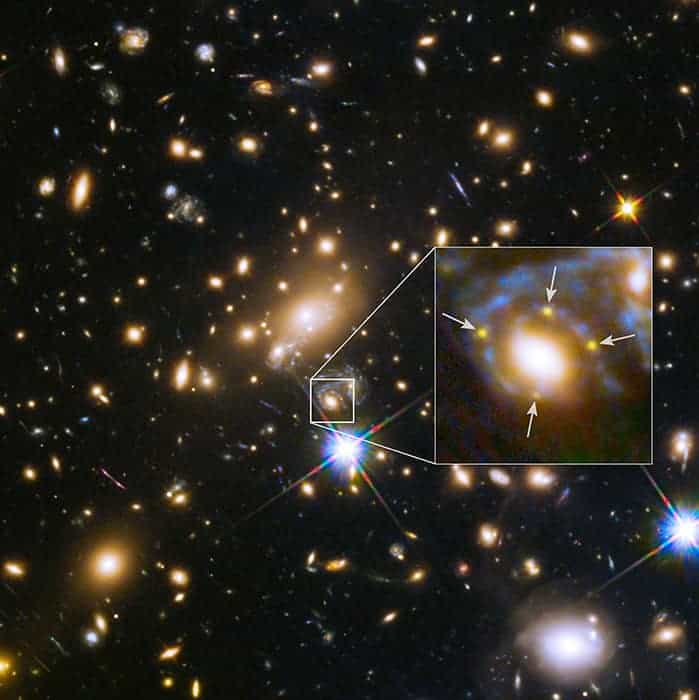
A comparison of data from gravitational lensing and gamma-ray observations has revealed that regions of the sky with greater concentrations of matter emit more gamma rays. The researchers who carried out the work conclude that much of the correlation is likely due to the action of supermassive black holes, but they say that some of the emission may be due to dark matter.
When light travels to Earth from a distant object it can be affected by the warping of space caused by the gravity of massive objects that it passes on the way. This results in a distortion of the image of the object that we see — and the type and degree of distortion reveals the distribution of mass along the light’s path. After accounting for all the visible foreground objects, what remains in the mass distribution is assumed to be dark matter – a still undetected substance that is reckoned to make up about 25% of the universe’s energy/mass content.
Astrophysicists also study emissions of gamma rays from places that are believed to contain lots of dark matter – such as the centre of the Milky Way. This radiation could be generated when hypothetical dark matter called weakly interacting massive particles (WIMPs) collide and annihilate one another. To date, however, those studies have been inconclusive as to the existence of WIMPs.
Unresolved sources
The latest work scrutinizes nine years’ worth of gamma-ray data from the Large Area Telescope onboard NASA’s Fermi satellite. Those data have previously revealed many individual gamma-ray sources, such as the remnants of supernova explosions or blazars – jets of ionized matter produced when supermassive black holes at the centre of some galaxies accrete surrounding material. However, those sources cannot account for all the detected radiation. Instead, objects too faint to be revealed individually generate what is known as the unresolved gamma-ray background.
The study was done by Simone Ammazzalorso at the University of Turin in Italy and colleagues, who have compared gamma-ray background measurements with the first year of data from the Dark Energy Survey – optical snapshots of 40 million galaxies obtained by the Dark Energy Camera on the 4 m Victor M Blanco Telescope in Chile. Their aim was to establish whether there is any correlation between the positions of gravitational lenses – deduced from the stretching of distant galaxies – and gamma-ray photons, as is predicted. As they report in Physical Review Letters, the answer is yes.
Scrutinizing the two sets of data for common patterns, the researchers found that regions of the sky containing more matter also emit more gamma rays and that, conversely, there are fewer gamma rays from less dense regions. Specifically, they confirmed the existence of such a correlation at high energies and small angular scales – less than 0.3°– with statistical significance of greater than 5σ, a value that is generally considered to indicate a discovery.
Blazars in the frame
To establish what might be responsible for that emission, the team plugged the data into computer models that simulate how various celestial objects generate gamma rays. Doing so, they concluded that most of the correlation is likely due to blazars, which are essentially point-like objects.
However, the researchers found that an extra ingredient was probably needed to account for a second, weaker, correlation at larger angular scales. They established at the level of 3σ that their models reproduce the observed data, including energy and red-shift components, more faithfully when they include dark matter among the gamma-ray emitters than when they don’t.
“This result is exciting as it marks one of the few hints at the existence of dark matter via indirect detection methods, and it opens up new possibilities for probing dark matter particle models,” according to Francesca Calore, an astroparticle physicist at Annecy-le-Vieux Theoretical Physics Lab in France, who wrote a commentary piece to accompany the paper describing the research.

Gravitational lensing creates ‘Einstein’s cross’ of distant supernova
However, Calore cautions that scientists do not completely understand the physics of blazars, arguing it is still possible that even the correlation at large angular scales “comes entirely” from these objects. Getting a firmer idea of dark matter’s contribution to the unresolved gamma-ray background, she says, will require fresh data.
Indeed, the Dark Energy Survey is due to release an enlarged data set, containing observations of 100 million galaxies, in the summer. Beyond that, the Legacy Survey of Space and Time at the Vera Rubin Observatory in Chile should provide data on billions of galaxies over a larger area of the sky after it opens for business in 2022. That year should also see the launch of the European Space Agency’s Euclid telescope, designed to better understand dark energy and dark matter by comparing the shape and redshift of galaxies.
“With deeper redshift coverage and a better angular resolution, future instruments will enable scientists to better understand the sources behind the universe’s gamma-ray glow and, potentially, uncover the nature of dark matter,” says Calore.



